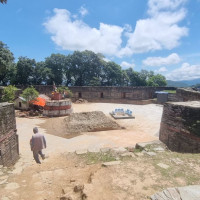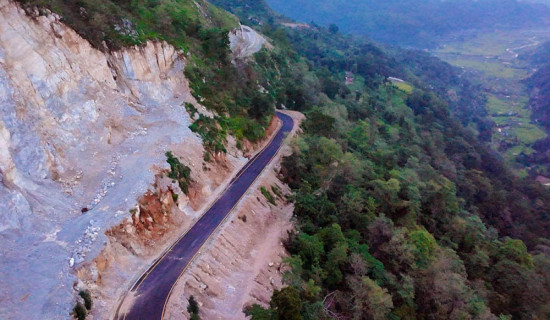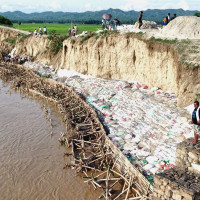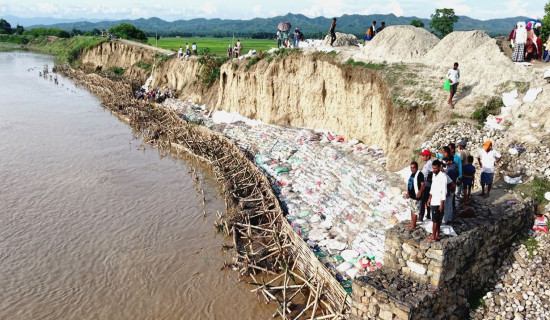- Wednesday, 16 July 2025
Poor transport, superstition make snakebite treatment difficult
By Lila Raj Khadka/Gokarna Dayal / Nayak Paudel, Jhapa/Baitadi/Kathmandu, Sep.1: It is still raining in different parts of the country. As the rain continues, the cases of snakebites are also reported from across the country.
Moreover, while the cases of snakebites were mostly reported from the Tarai region until a few years ago, the cases have been increasing in the Hilly region and above in recent years.
Nepali authorities have been taking several steps to prevent and treat snakebites. As per the Department of Health Services (DoHS), until the end of the fiscal year 2021/22, 88 snakebite treatment centres were in operation in the country, mostly in the Tarai, in collaboration with the Nepali Army, Nepal Red Cross Society and community members.
Nepal has also been distributing anti-snake venom serum (ASVS) for free since 1999/2000. According to the treatment centres, the government had managed a timely supply of ASVS, preventing any shortages during emergency and peak season.
There are more than one government authority overseeing snakebite cases. Alongside the Zoonotic Section of the Epidemiology and Disease Control Division (EDCD), under the DoHS, working as a focal body for snakebites, details related to snakebites are also collected by the Nepali Army and the National Disaster Risk Reduction and Management Authority (NDRRMA).
Nevertheless, there are still shortcomings in the sector, including a lack of accurate data, proper transport facilities to snakebite treatment centres and superstitious beliefs.
No accurate data
According to an annual report of the DoHS, 9,346 cases of snakebite were reported from across the country in the fiscal year 2021/22. Of them, 8,420 were non-poisonous and 926 were poisonous.
On the other hand, the World Health Organisation (WHO), citing a lack of accurate data, estimates that around 20,000 people are bitten by snakes in Nepal annually, resulting in over 1,000 deaths.
The report categorised snakebite data under cures and deaths
until 2017/18; however, there is no information on the number of cures and deaths after 2018/19.
The NDRRMA, which was established in December 2019, has also been keeping track of snakebites. Since April 14, 2023, the NDRRMA data shows 13 cases of snakebite with eight deaths as of August 30.
Meanwhile, Nepali Army (NA) data show that 1,624 cases of snakebite were treated within a month period (June 29, 2023, to July 29, 2023) in the treatment centres under eight NA headquarters throughout the country.
As per the NA, its treatment centres treated 2,624 snakebite cases from April 27 to July 29 this year.
Meanwhile, snakebite victims and stakeholders informed that there were still challenges to receive snakebite treatment effectively.
Poor transport
The National Guidelines for Snakebite Management in Nepal by the EDCD states that the most common cause of snakebite death in Nepal is envenoming resulting in respiratory paralysis (and rarely shock due to bleeding from Russell’s viper envenoming).
“In one of the community-based studies, 80 per cent of the patients with envenoming died before reaching a snakebite treatment centre. Rapid transport using motorcycles by seating the victim between rider and pillion has been found to decrease mortality in Nepal,” read the national guideline.
However, there are no proper roads in the rural areas, making it difficult to transport a snakebite victim to the treatment centre on time. Experts argued that snakebite cases are highly reported in rural areas of Nepal.
On Monday, locals of Mai Municipality in Jhapa district, a district with four snakebite treatment centres, had to prepare a temporary boat with bamboo to transport a snakebite victim by crossing the Kankai River.
The make-shift boat was made to carry Gopal Rai, a resident of Kankai. Rai had reached Mai Municipality as a guest in his relative’s house. However, he was bitten by a Tibetan pit viper, commonly known as haryou sarpa, at around 8 pm.
While the road was damaged by incessant rain, the locals had to make a boat to cross the river and take Rai to the treatment centre in Ward No. 4 of Kankai Municipality.
“I could see how the individuals made a boat somehow to cross the river. It took two hours to reach the treatment centre. I am thankful that I survived due to their hard work,” said Rai.
According to the Kankai Sahara Snakebite Treatment Centre, which has seven beds with two supported by ventilators, at least four snakebite victims arrive there on a daily basis.
“Snakebite patients from Ilam district as well as India arrive here for treatment. Since mid-July, around 70 patients came here for treatment and all of them were cured,” said Yadu Dhakal, a health personnel at the Kankai-based snakebite treatment centre.
Superstitious beliefs
Health experts stressed that snakebite cases are easily treatable if the patient is rushed to a treatment centre on time. While poor transport facility was one of the hurdles, superstitious beliefs have been another.
Parbati Ghatal, a 55-year-old of Pancheshwor Rural Municipality of Baitadi district, was bitten by a snake at 7 pm on Tuesday. However, rather than rushing her to a treatment centre, a shaman was called.
As Ghatal could not receive treatment on time since the shaman was attending to her, she died at 1 am on Wednesday.
In Baitadi, snakebite cases are treated in the District Hospital. However, health personnel in the hospital informed that there was often a delay in bringing a snakebite victim due to superstition.
Snakebite has claimed three lives in Pancheshwor and one in Sigas Rural Municipality of Baitadi this fiscal year.
In June, 55-year-old Kari Damai of Sigas died after not receiving treatment on time.
“Locals get informed through gossip regarding how a snakebite victim died for lack of timely treatment. However, when someone is bitten by a snake once again, the shaman is called rather than rushing him/her to a treatment centre,” said Dr. Dipesh Shrestha, medical superintendent of the Baitadi District Hospital.
Health personnel informed that the shamans cut the snakebite area and performed unnecessary steps leading the poison to reach every part of the body before arriving at a health centre.
















